Electric
Cars
General
B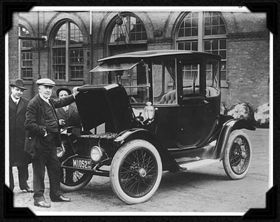 attery
Electric Vehicles (BEVs) were among the earliest automobiles, and are
more energy-efficient than all internal combustion vehicles. A petrol
internal combustion engine is approx 25% energy efficient, a diesel
approx 40% energy efficient while an AC Induction electric motor is
approx 95% energy efficient (excluding electricity generation
considerations).
attery
Electric Vehicles (BEVs) were among the earliest automobiles, and are
more energy-efficient than all internal combustion vehicles. A petrol
internal combustion engine is approx 25% energy efficient, a diesel
approx 40% energy efficient while an AC Induction electric motor is
approx 95% energy efficient (excluding electricity generation
considerations).
They
produce no exhaust fumes, and minimal pollution if charged from most
forms of renewable energy. Many are capable of acceleration
performance exceeding that of conventional gasoline powered vehicles.
BEVs
reduce dependence on petroleum, may mitigate global warming by
alleviating the greenhouse effect, are quieter than internal
combustion vehicles, and do not produce noxious fumes.
Thomas
Edison with a 1913 Detroit Electric car (~5000 sold; up to 340 km on
a single charge!!!, 32km/h top speed)
High
costs, limited travel distance between battery recharging, charging
time, and battery lifespan are drawbacks traditionally attributed to
the limited adoption of the BEV.
Emerging
technological and battery advancements, however, are addressing these
issues and enhancing the market competitiveness of the vehicle.
Though
some models are still in limited production, most popular roadworthy
BEVs have been withdrawn from the market and have been destroyed by
their manufacturers. A handful of future production models have been
announced, although many more have been prototyped. The major US
automobile manufacturers have been accused of deliberately sabotaging
their electric vehicle production efforts. Oil companies have used
patent protection to keep modern battery technology from use in BEVs.
http://en.wikipedia.org/wiki/Battery_electric_vehicle
History
T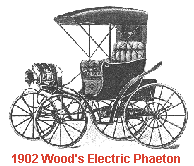
he
improvement of the storage battery, by Frenchmen Gaston Plante in
1865 and by Camille Faure in 1881, paved the way for electric
vehicles to flourish. France and Great Britain were the first nations
to support the widespread development of electric vehicles.
Bellis,
M. (2006) "The History of Electric Vehicles: The Early Years"
http://inventors.about.com/library/weekly/aacarselectrica.htm
The
Phaeton (see picture) had a range of 18 miles and a top speed of 14
mph
The first
car to break the 100km/h speed barrier was an electric car driven by
Camille Jenatzy on April 29, 1899. In his 'rocket-shaped' EV La
Jamais Contente he reached a top speed of 105.88 km/h.
Another
blow to BEVs was the loss of Edison's direct current electric power
transmission system in the War of Currents. This deprived the BEV of
the source of DC current necessary to recharge their batteries. As
the technology of rectifiers was still in its infancy, producing DC
current locally was unfeasible. http://en.wikipedia.org/wiki/
B2a2_1
Batteries
for electric cars
As the
following information shows, we already have all of the required
battery technology. What is worthwhile noting is that Chevron Oil
acquired the patent on high capacity NiMH batteries (which have the
long life span), which runs out only in 2014. Chevron does not seem
to use or allow anyone else to use that technology. (see also EV1
paper)
C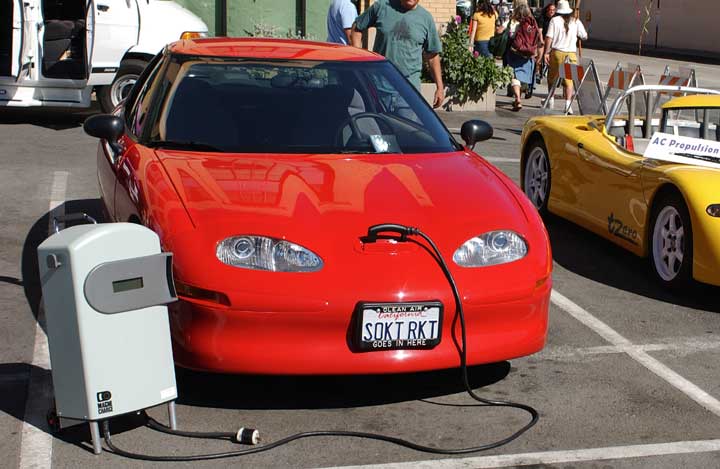
harging
In 1995,
some charging stations charged BEVs in one hour. In November 1997,
Ford purchased a fast-charge system produced by AeroVironment called
"PosiCharge" for testing its fleets of Ranger EVs, which
charged their lead-acid batteries in between six and fifteen minutes.
In February 1998, General Motors announced a version of its "Magne
Charge" system which could recharge NiMH batteries in about ten
minutes, providing a range of sixty to one hundred miles.
http://www.toshiba.co.jp/about/press/2005_03/pr2901.htm
In 2005,
handheld device battery designs by Toshiba were claimed to be able to
accept an 80% charge in as little as 60 seconds.
Anderson, C.D. and Anderson, J. (2005) "New
Charging Systems" Electric and Hybrid Cars: a History (North
Carolina: McFarland & Co., Inc.) ISBN
0-7864-1872-9, p. 121
However
such charge rates could cause excessive heat until more efficient
charging systems are developed.
Li-ion,
Li-poly and zinc-air batteries have demonstrated energy densities
high enough to deliver range and recharge times comparable to
conventional vehicles.
L ifespan
ifespan
In real
world use, some fleet Toyota RAV4 EVs, using NiMH batteries, have
exceeded 100,000 miles (160,000 km) with little degradation in their
daily range.
http://www.evchargernews.com/miscfiles/sce-rav4ev-100k.pdf
Range
New
lithium-ion battery-equipped EVs provide 250-300 miles (400-500 km)
of range per charge.
http://www.acpropulsion.com/LiIon_tzero_release.pdf
Cost
Charging
costs per kilometer driven are about one sixth the price of petrol or
less.
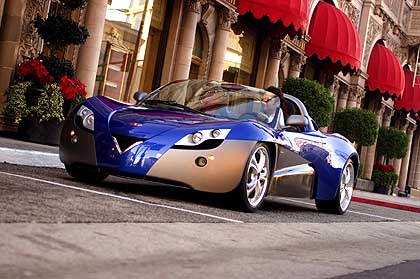
Electric
Car Performance
The
Venturi Fetish (pictured) is capable of reaching 0-100km/h in 4.5
seconds, despite a relatively modest 250 horsepower, and a top speed
of around 100 miles per hour. It has a range of 250km and recharges
in one hour.
http://en.wikipedia.org/wiki/
B2a2_2
Some
Electric Vehicle Production Announcements:
Following
are some BEV models which have been announced as entering production:
M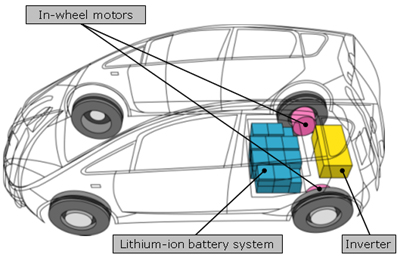
itsubishi
plans to mass-produce its Mitsubishi In-wheel Electric Vehicle
(MIEV) in 2008. The first test car, a Colt EV (see sketch), has a
top speed of 150km/h and a range of 150 km (93 miles) using
lithium-ion batteries and in-wheel electric motors. Mitsubishi
Motors has already built several test vehicles using lithium-ion
battery systems, including the Mitsubishi HEV in 1996, the FTO-EV in
1998 and the Eclipse EV in 2000, which covered over 400 km on public
roads on a single battery charge. The target price of a MIEV should
be around US$ 20,000.
http://media.mitsubishi-motors.com/
Plug-in
hybrid electric vehicles have been developed by the California Cars
Initiative, Edrive Systems, Hybrids Plus and Hymotion. They take a
Toyota Prius, add more battery capacity and modify the controller.
Then they can get 250 mpg (1 L/100 km) by plugging in at home for a
small light charge each night. Edrive and Hymotion in 2005 announced
plans to modify other hybrid models, including the Ford Escape.
http://en.wikipedia.org/wiki/Plug-in_hybrid_electric_vehicle
S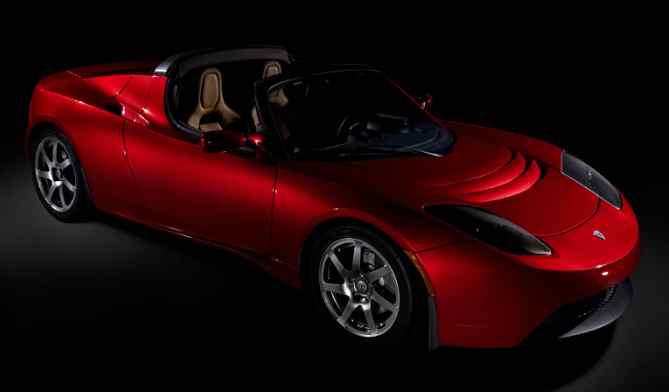
VE
(Société de Véhicules Électriques, a
company formed by the French Dassault and Heuliez group) announced
they will produce the Cleanova II (French only), based on the
Renault Kangoo. It will be available in pre-mass-production in 2007
and mass-production in 2008. The system exists in two versions: all
electric (200 km autonomy) and rechargeable hybrid (500 km
autonomy). The system include an electric engine developed by TM4 a
subsidiary of Hydro-Quebec, from Quebec Canada who developed also
since 20 years an electric wheel motor.
http://www.cleanova.com/public/sve/
The
Tesla Roadster (pictured on right), a two seat sports car to be
released in mid-2007 costing about US$ 90,000 to 100,000, travels
about 400 km on a single charge, with a top speed of over 200 km/h,
acceleration from 0-100 km/h in about 4 seconds, and a 1.7 L/100 km
equivalent operational cost at 2006 petrol prices
http://www.teslamotors.com/index.php?js_enabled=1
The
Venturi Electric sports car looks and drives great with 0-100km/h in
4.5 seconds (see image on previous page)
http://www.venturi.fr/Venturi-Fetish.html
Phoenix
motorcar, medium sized SUV or 4-door pickup with 150km/h top speed,
The battery pack can be recharged by 95% in 10 minutes and an
expected lifetime of over 400,000km.
http://www.phoenixmotorcars.com/
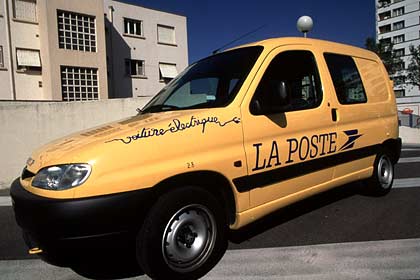
The
French Postal service will add 10,000 electric cars to their fleet
over the next 5 years, replacing over 15% of their fleet. The
changeover is expected to save 4000 tonnes of CO2 per year for each
vehicle.
Testing since 2005 of Type Cleanova II electric vehicles
(see above) in Paris und Bordeaux have shown them to be more
reliable, cheaper to maintain, quieter and have sufficient
range.
http://spiegel.de/
John
Kopcheff, from Victoria Petroleum, says most people will drive
electric cars within 30 or 40 years. "Petroleum, as actually the
fuel, transport fuel, I think less and less of that we'll see being
used." http://www.abc.net.au/news/newsitems/200705/s1911618.htm
B2a2_3
 attery
Electric Vehicles (BEVs) were among the earliest automobiles, and are
more energy-efficient than all internal combustion vehicles. A petrol
internal combustion engine is approx 25% energy efficient, a diesel
approx 40% energy efficient while an AC Induction electric motor is
approx 95% energy efficient (excluding electricity generation
considerations).
attery
Electric Vehicles (BEVs) were among the earliest automobiles, and are
more energy-efficient than all internal combustion vehicles. A petrol
internal combustion engine is approx 25% energy efficient, a diesel
approx 40% energy efficient while an AC Induction electric motor is
approx 95% energy efficient (excluding electricity generation
considerations).


 ifespan
ifespan


